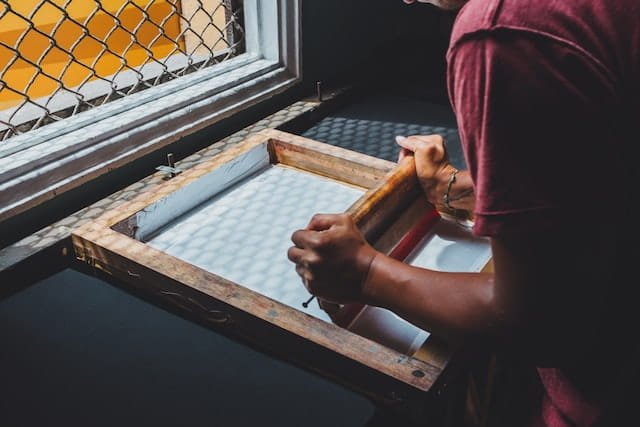Are you looking for ways to get creative with your designs? If so, screen printing could be an excellent choice for you. In this blog post, we will explore all the basics of screen printing – from what it is to the different techniques used and tips on how to create great prints. So read on and start getting your graphics ready – you’ll soon be mastering the art of screen printing!
Introduction to Screen Printing
Screen printing is a versatile and popular printing technique that can be used for a variety of applications, from t-shirts to posters to fabric. It is a great option for those looking for a high-quality, durable print.
There are three main elements to screen printing: the screen, the ink, and the substrate. The screen is made of a fine mesh material, which is stretched over a frame. The ink is placed on the screen and then pressed through the mesh onto the substrate. The substrate can be anything from paper to fabric to glass.
It is a great option for large prints, as well as for prints that require multiple colors.
Different Types of Screen Printing Techniques
In this type of printing, there are a variety of techniques that can be used to create different effects.
The most common types of screen printing techniques are spot color printing, four-color process printing, and simulated process printing.
Spot color printing is the simplest and most commonly used screen printing technique. It involves using one or two colors of ink to print an image on a substrate. This type of screen printing is typically used for simple designs or for creating prototypes.
Four-color process printing is a more complex screen printing technique that uses four colors of ink to print an image on a substrate. This type of printing can typically uses for complex designs or for full-color images.
Simulated process printing is a printing technique that uses a limited number of colors to create the illusion of a full-color image. This type of screen printing also typically uses for simple designs or for creating prototypes.
How to Select a Screen Printing Machine
There are a few things to consider when selecting a screen printing machine. The type of machine, the capabilities, the price, and the maintenance required are all important factors.
The type of machine is a significant consideration. There are two basic types of devices: flatbed and rotary. Flatbed machines are lower in cost and easier to maintain, but they have some limitations. Rotary machines are more expensive but offer a wider range of capabilities.
The capabilities of the machine are another essential consideration. Some machines can only print on small items, while others can handle large jobs. Others have special features like automatic registration or white ink capability. Choose a machine that has the features you need for your business.
The price is also a significant consideration when selecting a screen printing machine. There are machines that range in price from several hundred dollars to many thousands of dollars. Select a machine that fits your budget and your needs.
Finally, consider the maintenance required for the machine you select. Some machines require very little maintenance, while others require regular cleaning and servicing. Be sure to pick a machine that you can keep in good working order.
What does Material use for Screen Printing?
It is a versatile printing technique that can use on a variety of materials, including paper, fabric, glass, metal, and plastic. The type of material you select will affect the printing process and the finished product.
- Paper: Paper is the most common substrate for screen printing. It is inexpensive and easy to work with. Screen printing on paper can produce both simple and complex designs.
- Fabric: Fabric is another popular substrate for screen printing. It can use to create clothing, bags, and other textile products. Printing on fabric commonly uses to create unique patterns and designs.
- Glass: Glass is a challenging substrate to print on, but it can produce stunning results. Screen printing on glass requires special inks and techniques.
- Metal: Metal is a durable substrate to print using traditional screen printing inks or specialty inks designed for metal substrates. Metal screen prints can use for both indoor and outdoor applications.
- Plastic: Plastic is a versatile substrate to print using traditional screen printing inks or specialty inks designed for plastic substrates. Plastic screen print commonly uses for signage, displays, and labels.
Setting Up Your Design For Screen Printing
You’ll need to set up your design correctly before you can screen print it onto your fabric or surface. To do this, you’ll need to create a stencil of your design. This can over using a variety of methods, including hand-cutting or using a software program like Adobe Photoshop.
Once you have your stencil ready, you’ll need to set up your screen printing frame. This is a simple wood or metal frame that will hold your fabric in place while you print. You can buy these frames pre-made, or make one using simple materials.
Next, you’ll need to stretch your fabric tight across the frame and secure it in place. Then, you’ll attach your stencil to the frame and start printing! Use a squeegee to apply even pressure as you pull it across the stencil, and remove any excess ink before moving on to the next color.
With a little practice, screen printing is a fun and easy way to add personalized designs to all sorts of surfaces!
Tips for Achieving Quality Prints
As we continue our series on all things screen printing, today we’re going to focus on how to achieve quality prints. This is, of course, the goal of every screen printer but there are steps you can take – and avoid taking – to help ensure success.
First and foremost, it’s important to start with a high-quality image. That means a resolution of at least 300 DPI (dots per inch) and, ideally, an EPS or vector file. If you don’t have access to those types of files, a JPEG at full size can work but it won’t be quite as crisp as the other options.
Once you have your image, the next step is to prepare your screens. This involves coating them with a light-sensitive emulsion and then exposing them to UV light. The longer you expose them, the harder the emulsion will become, and the finer the detail in your image will be. Conversely, if you expose them for too short of a time, the emulsion will be too soft and your prints will be fuzzy.
After your screens are ready, it’s time to set up your printing station. You’ll need a frame to hold your screen in place, something to catch the ink as it passes through the screen (a piece of cardboard or paper works well), and some kind of squeegee. Most importantly, make sure everything is level – an uneven surface will.
How to Care for and Store the Screens
Assuming you’re referring to screen printing screens:
After each use, screens should air to be with a gentle soap and water solution. Avoid using harsh chemicals or abrasive cleaners, as these can damage the screen. Rinse the screen thoroughly to remove all traces of cleaner before storing.
Screens can store flat or hung vertically. If storing flat, be sure to support the screen so that it doesn’t sag in the middle and cause distortion.
Business Benefits of Using Screen Printing
There are many benefits to using screen printing for your business. It is a versatile printing technique that can use on a variety of different materials, including paper, cardboard, plastic, metal, and glass. This makes it ideal for a wide range of businesses, from small businesses to large corporations.
It is also a very cheap printing method. It is fast and efficient, which means that you can print large quantities of prints quickly and cheaply. This makes it ideal for businesses that need to print a lot of marketing materials or promotional items.
Another benefit of screen printing is that it produces high-quality prints. The prints are resistant to fading and smudging, so they will look great for a long time. This makes them perfect for use in advertising and marketing campaigns where you want your printed materials to look their best.
Overall, It is an excellent choice for businesses of all sizes that need high-quality, affordable prints. It is versatile, cost-effective, and produces printed materials that look great and last long.
Conclusion
Screen printing is a great way to create professional, high-quality prints with various effects. With the right tools and knowledge, anyone can learn this art form. Luckily there are plenty of resources available online to help you can get birth. We hope that this article has given you an insight into the world of screen printing, as well as some helpful tips and techniques for producing your own unique artwork!






